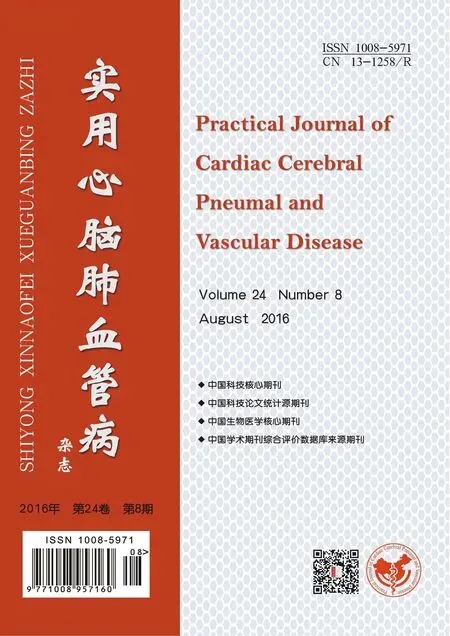广东省阳江市健康体检人群代谢综合征患病现状调查
谢绍洽,梁羡方,欧家满
·调查研究·
广东省阳江市健康体检人群代谢综合征患病现状调查
谢绍洽,梁羡方,欧家满
目的调查广东省阳江市健康体检人群代谢综合征(MS)患病现状。方法采用随机分层抽样方法于2013年12月—2015年9月抽取广东省阳江市30岁以上的健康体检者981例作为调查对象,采用自制问卷采集调查对象的相关信息;所有调查对象进行体格检查、实验室检查,分析MS患病情况。结果共发放问卷981份,回收有效问卷966份,有效率为98.5%。966例健康体检人群中185例诊断为MS,MS患病率为19.2%,其中男性MS患病率为21.6%(100/464),女性MS患病率为16.9%(85/502),男性与女性MS患病率比较,差异无统计学意义(P>0.05)。青年组男性MS患病率高于女性(P<0.05),而中年组、老年组男性与女性MS患病率比较,差异无统计学意义(P>0.05)。966例健康体检者中检出腹型肥胖330例(34.2%),血糖升高160例(16.6%),血压(BP)升高475例(49.2%),高水平三酰甘油(TG)290例(30.0%),低水平高密度脂蛋白胆固醇(HDL-C)125例(12.9%)。不同性别健康体检者腹型肥胖、高水平TG检出率比较,差异无统计学意义(P>0.05);不同性别健康体检者血糖升高、BP升高、低水平HDL-C检出率比较,差异有统计学意义(P<0.05)。不同性别健康体检者0项MS指标异常检出率比较,差异有统计学意义(P<0.05);不同性别健康体检者1项MS指标异常、2项MS指标异常、3项MS指标异常、4项MS指标异常和5项MS指标异常检出率比较,差异无统计学意义(P>0.05)。结论广东省阳江市健康体检者MS患病率较高,且不同性别、年龄健康体检者MS表现不同,需进行有针对性的干预。
代谢综合征X;阳江市;数据收集;横断面研究
谢绍洽,梁羡方,欧家满.广东省阳江市健康体检人群代谢综合征患病现状调查[J].实用心脑肺血管病杂志,2016,24(8):82-84.[www.syxnf.net]
XIE S Q,LIANG X F,OU J M.Prevalence of metabolic syndrome in crowd undergoing medical examination in yangjiang,Guangdong province[J].Practical Journal of Cardiac Cerebral Pneumal and Vascular Disease,2016,24(8):82-84.
代谢综合征(MS)又称X综合征、胰岛素抵抗综合征,其是由肥胖、高血压、糖尿病、胰岛素抵抗、血脂代谢紊乱、动脉粥样硬化及心脑血管疾病等多种疾病所致的代谢成分异常聚集的一组症状群,严重影响人们的健康[1]。随着人们生活水平的提高,近年来MS的发生率呈逐年上升趋势,但目前有关MS患病现状的研究报道较少。本研究旨在调查广东省阳江市健康体检人群MS患病现状,为临床制定相关的预防政策提供参考,现报道如下。
1 对象与方法
1.1调查对象于2013年12月—2015年9月,采用随机分层抽样方法抽取广东省阳江市30岁以上的健康体检者981例。纳入标准:(1)同意参与本研究并签署知情同意书;(2)年龄≥30岁;(3)无心脑血管疾病(如冠心病、脑梗死等)。
1.2调查方法于调查开始前1~2周对调查人员进行培训,后通过现场、面访方式对调查对象进行问卷调查、体格检查及实验室检查。
1.2.1问卷调查采用自制问卷采集调查对象的相关信息,包括年龄、性别、职业、吸烟情况、饮酒情况、生活习惯、既往病史等。
1.2.2体格检查包括身高、体质量、体脂率、内脏脂肪指数、腰围、心脏及腹主动脉超声检查、心电图等。
1.2.3实验室检查采集调查对象清晨空腹静脉血,检测血脂七项、血钾、血肌酐、血糖、尿微量蛋白等。实验室检查均由同一位检验师采用双盲法在统一标准下完成。
1.3MS的诊断标准参考2012年中国成人血脂异常防治指南制订联合会制定的MS诊断标准[2],符合下述≥3项即可诊断为MS:(1)腹型肥胖(男性腰围>90 cm,女性腰围>85 cm);(2)三酰甘油(TG)≥1.70 mmol/L或已进行针对性治疗;(3)高密度脂蛋白胆固醇(HDL-C):男性<1.03 mmol/L,女性<1.29 mmol/L或已进行针对性治疗;(4)血压(BP)≥130/86 mm Hg(1 mm Hg=0.133 kPa)或有高血压病史;(5)空腹血糖(FBG)≥6.1 mmol/L、餐后2 h血糖≥7.8 mmol/L或有糖尿病病史。
1.4统计学方法数据录入采用Excel 2010软件,采用SPSS 20.0统计软件进行数据处理,计数资料采用χ2检验。以P<0.05为差异有统计学意义。
2 结果
2.1MS患病情况共发放问卷981份,回收有效问卷966份,有效回收率为98.5%;其中男464例,女502例,185例检出为MS,MS患病率为19.2%,男性MS患病率为21.6%(100/464),女性MS患病率为16.9%(85/502)。男性与女性MS患病率比较,差异无统计学意义(χ2=3.323,P>0.05)。
2.2不同年龄组及性别健康体检者MS患病情况青年组男性MS患病率高于女性,差异有统计学意义(P<0.05);中年组和老年组男性与女性MS患病率比较,差异无统计学意义(P>0.05,见表1)。
表1不同年龄组及性别健康体检人群MS患病率比较
Table 1Comparison of prevalence rate of MS in crowd undergoing medical examination with different age and different gender

年龄男性例数 患病率〔n(%)〕女性例数 患病率〔n(%)〕χ2值P值青年组(30~44岁)7517(22.7)895(5.6)10.1850.001中年组(45~59岁)11022(20.0)17621(11.9)3.4490.063老年组(≥60岁)27961(21.9)23759(24.9)0.6600.417
2.3MS组分异常检出情况966例健康体检者中检出腹型肥胖330例(34.2%),血糖升高160例(16.6%),BP升高475例(49.2%),高水平TG 290例(30.0%),低水平HDL-C 125例(12.9%)。不同性别健康体检者腹型肥胖、高水平TG检出率比较,差异无统计学意义(P>0.05);不同性别健康体检者血糖升高、BP升高、低水平HDL-C检出率比较,差异有统计学意义 (P<0.05,见表2)。
表2不同性别健康体检者MS组分异常检出率比较〔n(%)〕
Table 2Comparison of detection rate of MS components disorders in crowd undergoing medical examination with different gender

性别例数腹型肥胖血糖升高BP升高高水平TG低水平HDL-C男性464155(33.4)91(19.6)255(55.0)149(32.1)95(20.5)女性502175(34.9)69(13.7)220(43.8)141(28.1)30(6.0)χ2值0.1424.3314.2230.97535.991P值0.6430.0390.0450.3680.000
注:BP=血压,TG=三酰甘油,HDL-C=高密低脂蛋白胆固醇
2.4MS组分异常分布情况不同性别健康体检者0项MS指标异常检出率比较,差异有统计学意义(P<0.05);不同性别健康体检者1项MS指标异常、2项MS指标异常、3项MS指标异常、4项MS指标异常和5项MS指标异常检出率比较,差异无统计学意义(P>0.05,见表3)。
表3不同性别健康体检者MS组分异常分布情况比较〔n(%)〕
Table 3Comparison of distribution of MS components disorders in crowd undergoing medical examination with different gender

性别年龄0项MS指标异常1项MS指标异常2项MS指标异常3项MS指标异常4项MS指标异常5项MS指标异常男性464111(23.9)143(30.8)111(23.9)63(13.6)27(5.8)10(2.2)女性502174(34.7)136(27.1)110(21.9)50(10.0)24(4.8)11(2.2)χ2值7.5881.0920.4402.9660.6750.184P值0.0040.4120.6980.1420.4580.796
3 讨论
世界范围内,成年人MS患病率为20%~30%,且呈逐年上升趋势,但目前MS的诊断标准尚未统一[3]。MS由于地域、疾病状态、人种等因素,其患病率存在差异,研究认为MS患病率存在差异的原因与诊断标准不统一及MS高度特异性有关。本研究结果显示,广东省阳江市健康体检人群MS患病率为19.2%,高于上海市(17.49%)[4]、成都市(17.18%)[5-6],但低于东北地区(39.12%)[7],分析原因为阳江市为四线城市,人们的生活压力虽低于一、二线城市,但文化、健康生活认识存在差异,导致MS患病率升高。
有研究表明,心血管疾病发病率与MS组分异常(如血脂升高、BP升高、年龄增长、血糖升高等)有关,与无任何MS组分异常的人群相比,有3个或更多MS组分异常的人群临床心血管病发病率增加5倍以上[3,8-10]。目前研究表明,随着人们生活水平的提高,MS患病率呈逐年上升趋势[8-9]。本研究结果显示,青年组男性MS患病率高于女性,中年组和老年组男性与女性MS患病率间无差异;966例健康体检者中检出腹型肥胖330例(34.2%),血糖升高160例(16.6%),BP升高475例(49.2%),高水平TG 290例(30.0%),低水平HDL-C 125例(12.9%);不同性别健康体检者腹型肥胖、高水平TG检出率间无差异,不同性别健康体检者血糖升高、BP升高、低水平HDL-C检出率间有差异;不同性别健康体检者0项MS指标异常发生率间有差异,不同性别健康体检者1项MS指标异常、2项MS指标异常、3项MS指标异常、4项MS指标异常和5项MS指标异常发生率间无差异。说明对男性进行早期干预以预防MS尤为重要,且本地区健康体检者中肥胖是导致MS的主要原因,也不可忽视BP升高的影响。现代生活中人们由于脂肪摄入过多、运动量过少、高盐等饮食习惯导致肥胖、高血压、动脉粥样硬化、糖尿病等疾病的发生[10-14],使MS患病率提高,故生活中可通过减少脂肪摄入、低盐饮食、增加运动等预防MS的发生。MS是心脑血管疾病的高危因素,病死率和致残率较高,故通过调查广东省阳江市健康体检者MS患病情况,找出本地区MS发生的主要原因,可早期进行有针对性的临床干预,有利于预防和减少MS的发生。
综上所述,广东省阳江市健康体检者MS患病率较高,且不同性别、年龄健康体检者MS表现不同,需进行有针对性的干预。但本研究样本量较小,需扩大样本量进一步研究,为临床提供更准确的参考指标。
[1]The Expanding Pathogenic Role of Insulin Resistance in Human Disease[J].Diabet Med,2014.[Epub ahead of print].
[2]中国成人血脂异常防治指南制订联合委员会.中国成人血脂异常防治指南[M].北京:人民卫生出版社,2007.
[3]KLUPP N L,KIAT H,BENSOUSSAN A,et al.A double-blind,randomised,placebo-controlled trial of Ganoderma lucidum for the treatment of cardiovascular risk factors of metabolic syndrome[J].Sci Rep,2016(6):29540.
[4]DUVNJAK L,DUVNJAK M.The metabolic syndrome——an ongoing story[J].J Physiol Pharmacol,2009(7):19-24.
[5]阮晔,李锐,黎衍云,等.上海市成人代谢综合征的流行特征[J].中华内分泌代谢杂志,2010,26(9):740-744.
[6]陶世冰,任艳,冉兴无,等.2007年成都地区成人代谢综合征患病率的流行病学调查[J].四川大学学报(医学版),2009,40(6):1062-1065.
[7]王宾友,刘雅,黄晓波,等.成都地区老年人代谢综合征及其相关因素的流行病学调查[J].中国老年学杂志,2010,30(17):2498-2500.
[8]YU S,GUO X,YANG H,et al.An update on the prevalence of metabolic syndrome and its associated factors in rural northeast China[J].BMC Public Health,2014(14):877.
[9]KIM N H,PARK J H,PARK D I,et al.Metabolic syndrome is a risk factor for adenoma occurrence at surveillance colonoscopy:A single-center experience in Korea[J].Medicine(Baltimore),2016,95(32):e4454.
[10]FU Y,ZHOU Z,YANG B,et al.The Relationship between the Clinical Progression of Benign Prostatic Hyperplasia and Metabolic Syndrome:A Prospective Study[J].Urol Int,2016(11).[Epub ahead of print].
[11]XI B,HE D,HU Y,et al.Prevalence of metabolic syndrome and its influencing factors among the Chinese adults:the China Health and Nutrition Survey in 2009[J].Prev Med,2013,57(6):867-871.
[12]LI G,D E COURTEN M,JIAO S,et al.Prevalence and characteristics of the metabolic syndrome among adults in Beijing,China[J].Asia Pac J Clin Nutr,2010,19(1):98-102.
[13]WILSON P W,GRUNDY S M.The metabolic syndrome:a practical guide to origins and treatment:Part Ⅱ[J].Circulation,2003 ,108(13):1537-1540.
[14]WILSON P W,GRUNDY S M.The metabolic syndrome:practical guide to origins and treatment:Part Ⅰ[J].Circulation,2003,108(12):1422-1424.
(本文编辑:李洁晨)
Prevalence of Metabolic Syndrome in Crowd undergoing Medical Examination in Yangjiang,Guangdong Province
XIEShao-qia,LIANGXian-fang,OUJia-man.
DepartmentofCardiovascularMedicine,thePeople′sHospitalofYangdongDistrict,Yangjiang,Yangjiang529500,China
ObjectiveTo investigate the prevalence of metabolic syndrome in crowd undergoing medical examination in Yangjiang,Guangdong province.MethodsA total of 981 medical examination people over 30 years old were enrolled in this study by random stratified sampling method from December 2013 to September 2015,all of them received physical examination and laboratory examination,and the prevalence of metabolic syndrome was analyzed;self-made questionnaire was used to collect relate information.ResultsA total of 966 effective questionnaires were recycled,the effective recycle rate was 98.5%(966/981).The prevalence rate of metabolic syndrome was 19.2%(185/966),thereinto prevalence rate of metabolic syndrome of male was 21.6%(100/464),that of female was 16.9%(85/502),the difference was not statistically significantly different(P>0.05).The prevalence rate of metabolic syndrome of young male was statistically significantly higher than that of young female(P<0.05),while no statistically significant differences of prevalence rate of metabolic syndrome was found between middle-age male and middle-age female,or between old-age male and old-age female(P>0.05).Of the 966 people undergoing medical examination,330 cases found abdominal obesity(accounting for 34.2%),160 cases found elevation of blood glucose(accounting for 16.6%),475 cases found elevation of BP(accounting for 49.2%),290 cases found elevation of TG(accounting for 30.0%),125 cases found reduction of HDL-C(accounting for 12.9%).No statistically significant differences of detection rate of abdominal obesity or elevation of TG was found in people with different gender(P>0.05),while there were statistically significant differences of detection rates of elevation of blood glucose,elevation of BP and reduction of HDL-C in people with different gender(P<0.05).There was statistically significant difference of detection rate of zero-indicator abnormity of metabolic syndrome in people with different gender(P<0.05),while no statistically significant differences of detection rate of one-indicator abnormity of metabolic syndrome,two-indicator abnormity of metabolic syndrome,three-indicator abnormity of metabolic syndrome,four-indicator abnormity of metabolic syndrome or five-indicator abnormity of metabolic syndrome in people with different gender(P>0.05).ConclusionThe prevalence rate of metabolic syndrome is relatively high in crowd undergoing medical examination in Yangjiang,Guangdong province,and the features of metabolic syndrome is changeful in people with different age and gender,and targeted intervention measures should be taken.
Metabolic syndrome X;Yangjiang city;Data collection;Cross-sectional studies
2014年广东省阳江市科技项目(社发【2014】82)
529500广东省阳江市阳东区人民医院心血管内科(谢绍洽,梁羡方);阳江市人民医院心血管内科(欧家满)
R 589
A
10.3969/j.issn.1008-5971.2016.08.022
2016-05-09;
2016-08-13)

